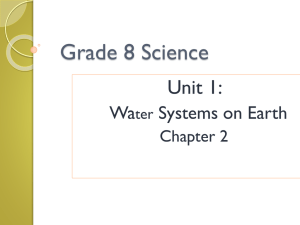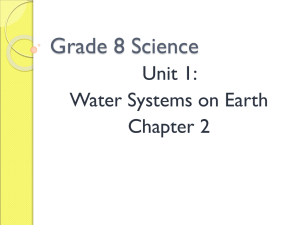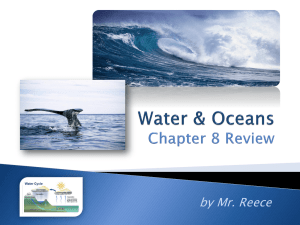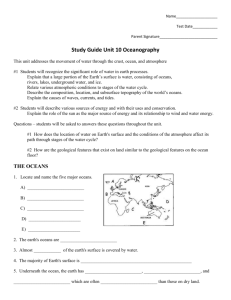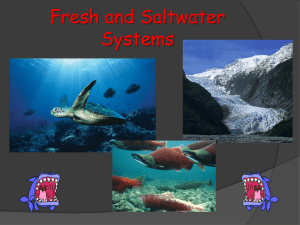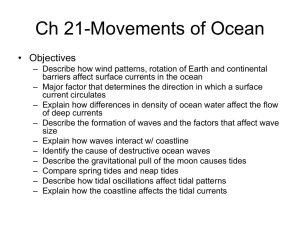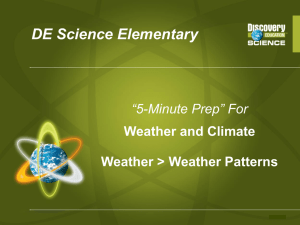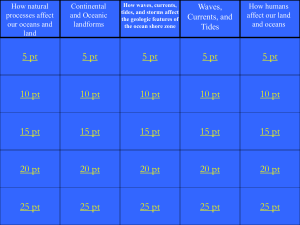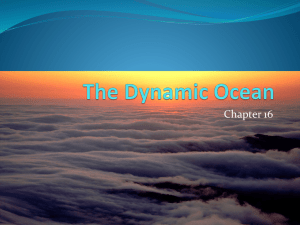Ocean Motions
advertisement
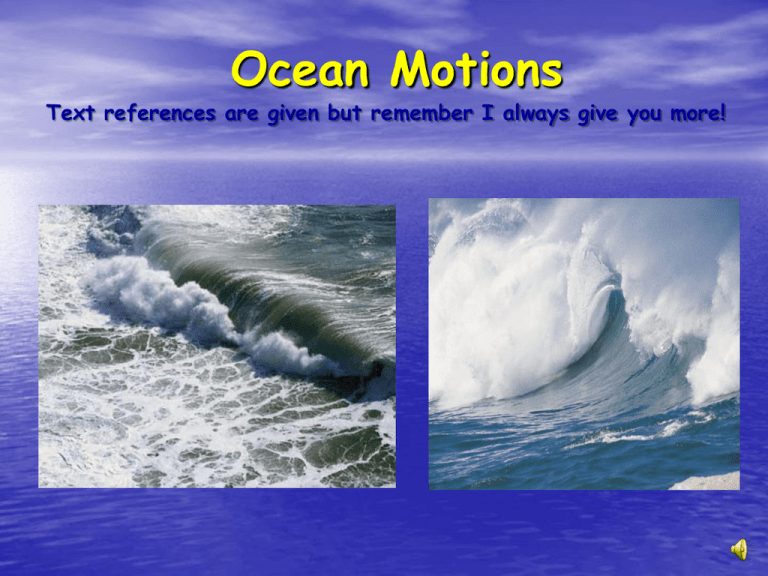
Ocean Motions Text references are given but remember I always give you more! I. Currents (pgs. 84-88) A. Ocean water contains horizontal, stream-like movements of water called ocean currents. B. Affected by weather, Earth’s rotation, and the position of the continents. C. Importance: 1. moves drifting organisms from place to place – plankton, disperse young 2. carries eggs and larvae of organisms that have external fertilization 3. brings food, oxygen 4. carries away waste, pollutants D. Three Main Types 1. Surface Currents a. Horizontal movements of ocean water caused by wind and occurring at or near the ocean’s surface are called surface currents. b. Can reach depths of several hundred meters and lengths of several thousand kilometers. c. The Gulf Stream is one of the longest surface currents, transporting 25 times more water than all the rivers in the world combined. d. Controlled by 3 factors: Global winds Continental Coriolis barriers Effect d1. Global Winds • Different winds cause currents to flow in different directions. – The trade winds are located just north and south of the equator. • In both hemispheres, they push currents westward across the tropical latitudes. – The westerlies are located in the middle latitudes. d2. Continental Barriers • The continents are another major influence on surface currents. – They act as barriers to these currents. – When a surface current flows against a continent, the current is deflected and divided. d3. Coriolis Effect • As Earth rotates, ocean currents and wind belts curve. – The curving of the paths of ocean currents and winds due to Earth’s rotation is called the Coriolis Effect. – The wind belts and the Coriolis Effect create huge circles of moving water, called gyres. 2. Deep Currents a. Stream-like movements of ocean water located b. c. far below the surface are called deep currents. Move much slower than surface currents. Form as cold, dense water of the polar regions sinks and flows beneath warmer ocean water. • The density of ocean water if affected by temperature and salinity. – Decreasing temperature and increasing salinity will increase the water’s density. Cold water is more dense than warm water! d. when combined with surface currents, results in conveyor belt movement of water around globe 3. upwelling a. wind blows, moves water away, causes new water to rise up to replace it b. brings up tiny ocean organisms, minerals, and other nutrients from the deeper layers of the water. E. Currents and Climate 1. Currents can greatly affect the climate in many parts of the world. – Warm-water currents: • The Gulf Stream carries warm water from the Tropics to the North Atlantic Ocean. – Cold-water currents: For example: The California current carries cold water from the North Pacific Ocean toward Mexico along the western coast of the USA therefore, cooler climate year-round than inland states. 2. Every 2 to 12 years, the South Pacific trade winds move less warm water to the western Pacific than they usually do. a. El Niño-Pacific Ocean trade winds slow and almost stop which brings warmer conditions and weak upwelling currents to the eastern Pacific which hurts fishing in Peru b. La Niña-winds blow stronger than normal pushing warm water out and allowing cold water in. A stronger upwelling occurs. Normal Conditions El Niño Conditions La Niña Conditions II. Waves (pgs. 89-93) 1. A Wave is a rhythmic movement that carries energy through matter or space. 2. When a wave passes through the ocean, individual water molecules move up and down in a circular motion but they do not move forward or backward 3. As waves approach shore, the wave length decreases and wave height increases 4. When a wave breaks against the shore, the crest outruns the trough and the crest collapses-this is called a breaker (water moves forward and backward at this point). 5. Parts of a Wave a. Crest – highest point of a wave b. Trough – lowest point of a wave c. Wave Height – vertical distance d. between the crest and the trough Wavelength – horizontal distance between two crests or two troughs PLEASE DRAW AND LABEL Wavelength Wave Height Crest Still Water Trough Wave Parts 5. Effects of Waves on Shore a. Longshore current- As waves come into shore, water washes up the beach at an angle, carrying sand grains. The water and sand then run straight back down the beach. 5b. Rip Current-long ridges or piles of sand create sand bars. A break in a sand bar allows a fast-moving narrow stream of water through 6. Cause of Waves a. Wind – When wind blows across a body of water, friction causes the water to move along with the wind. – Wave Height depends on – • Wind speed • Distance over which the wind blows • Length of time the wind blows 6b. Earthquakes- Waves caused by earthquakes are called Tsunamis i. ii. iii. Tsunamis were once called Tidal waves, but they have nothing to do with the tides. They are produced by earthquakes and other seismic disturbances. That’s why they’re also called seismic sea waves. Sudden outflow of water then it returns much higher iii. Tsunamis are very long, fast moving waves! • They can have wavelengths of 150 miles, wave heights of 100 ft and move as fast as 450 mph (jet speed!). 6c. Gravitational force of the Moon and Sun creates Tides (pgs 96-100). i. The rise and fall in sea level is . called a tide. ii. One low-tide/high-tide cycle iii. takes about 12 hrs and 25 min. Tidal range is the difference in ocean level between high-tide and low-tide What is the Tidal Range? • HT = 30 ft, LT = 20 ft • HT = 20 ft, LT = 12 ft • HT = 50 ft, LT = 20 ft 10 ft 8 ft 30 ft iv. Gravitational Effect of the Moon • Two big bulges of water form on the Earth: –one directly under the moon –another on the exact opposite side • As the Earth spins, the bulges follow the moon. • These are normal daily tides v. Gravitational Effect of the Sun a. Spring Tides –Earth, Moon, and Sun are lined up and work together –High Tides are higher and Low Tides are lower than normal b. Neap Tides –Earth, Moon, and Sun form right angles and work against each other –High Tides are lower and Low Tides are higher than normal
